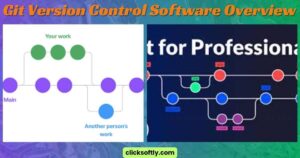Git Version Control Software Overview: Learn everything you need to know in 2025 about how Git works, its key features, benefits, and why it’s the go-to version control system for developers and teams worldwide.
Git is a powerful version control software. It helps manage changes in code efficiently.
Understanding Git can transform how you handle projects, especially in a team. It tracks every change, making collaboration seamless. With Git, you can revert to previous versions, explore different code branches, and merge changes smoothly.
This overview will guide you through the basics of Git, its features, and how it can benefit your workflow.
Whether you are a beginner or looking to refresh your knowledge, this post will provide clear insights into why Git is essential for modern software development. Stay with us as we dive into the world of Git and discover its key functionalities.

Git Version Control Software Overview, Key Features
Git is a powerful tool used by developers worldwide. It helps manage changes in code efficiently. Understanding its key features can improve your workflow. Let’s explore some of the essential aspects of Git.
Distributed Version Control
Git uses a distributed version control system. This means every developer has a full copy of the project. Each clone has the complete history of all changes. This allows for faster operations, like commits and merges. Developers can work offline and sync changes later.
Branching And Merging
Branching in Git is simple and efficient. You can create a new branch to work on a feature. This keeps your main codebase clean. Once the feature is complete, you can merge it back. Git handles merges smoothly. It ensures that changes integrate without conflicts.
Git Version Control Software Overview, Installation And Setup
Git is a popular version control software. It helps developers manage changes in their code. This section covers the installation and setup of Git. Let’s dive into the steps to get started with Git on your system.
Installing Git
First, download Git from the official website. Choose the version for your operating system. For Windows, get the .exe file. For macOS, you can use Homebrew. Linux users can use the package manager.
After downloading, run the installer. Follow the on-screen instructions. For macOS, open Terminal and type: brew install git. For Linux, use the command: sudo apt-get install git. After installation, verify it by typing: git --version in your terminal.
You should see the installed version number.

Initial Configuration
Configure Git with your name and email. These details appear in your commits. Open your terminal and type: git config --global user.name "Your Name". Then, set your email: git config --global user.email "you@example.com".
To see your configuration, type: git config --list. You can also customize other settings. For example, set your default text editor: git config --global core.editor "nano". With these basic configurations, Git is ready to use. Happy coding!
Git version control Basic Commands
Understanding the basic commands of Git version control software is crucial for efficient coding and collaboration. These commands help you navigate, track, and manage your projects seamlessly. Whether you’re new to Git or looking to refine your skills, mastering these commands will boost your productivity.
Creating A Repository
Creating a repository is the first step in using Git. A repository, often called a repo, is a storage space where all your project files and their revision history are kept.
To create a new repository, use the command:
This command initializes a new Git repository in your current directory. Think of it as setting up a new folder where Git will track changes.
Alternatively, if you’re starting a project from an existing repository, you can clone it using:
This command copies the existing repository to your local machine, allowing you to work on it.
Committing Changes
Committing changes is like saving your work with a detailed note. It helps in tracking the evolution of your project.
After making changes to your files, you need to stage them using:
Or to add all changes:
git add .
This prepares your changes for the next commit.
Once staged, commit these changes with:
Writing clear commit messages is essential. They should describe what changes were made and why. This practice helps when reviewing the project’s history.
Have you ever struggled to remember what you changed last week? Commit messages are your memory aid.
Git’s basic commands are fundamental yet powerful. They keep your workflow organized and collaborative. Are you using them effectively?

Branching Strategies, Git Version Control Software Overview
Branching strategies in Git are crucial for managing your codebase efficiently. They allow you to work on different features, fix bugs, and experiment without disrupting the main project. Let’s explore some popular branching strategies that can help streamline your workflow.
Feature Branch Workflow
The Feature Branch Workflow is one of the most straightforward strategies. Each feature or bug fix is developed in its own branch. This keeps the main codebase clean and stable.
Imagine you’re working on a new login feature. You would create a branch named feature/login. This makes it easy to switch back to the main branch if needed.
Once the feature is ready and tested, you merge it back into the main branch. This ensures that your main branch only contains stable code. Have you ever faced issues with conflicting changes? Feature Branch Workflow minimizes such risks by isolating changes.
Gitflow Workflow
The Gitflow Workflow is more structured and ideal for larger projects. It involves multiple branches, each serving a specific purpose. You have branches like develop, release, and hotfix.
Let’s say you’re preparing for a new release. You would create a release branch from develop. This branch is used for final adjustments before the release.
After the release, any urgent bug fixes are managed in the hotfix branch. These changes are then merged back into both main and develop branches. This ensures that the fixes are part of future development. Have you ever struggled with managing hotfixes and new features simultaneously? Gitflow Workflow offers a clear path for both.
Choosing the right branching strategy can make or break your development process. What challenges have you faced with branching in Git? Share your thoughts below!

Collaboration With Git
Git is not just a tool for version control; it’s a powerful platform for collaboration. Whether you’re working on a solo project or part of a large team, Git makes it easy to share code and work together seamlessly. Let’s explore how Git enhances collaboration through cloning repositories and pull requests.
Cloning Repositories | Git Version Control Software Overview
Imagine you’re starting on a new project. The first step is to get the code onto your local machine. This is where cloning repositories comes into play. By cloning a repository, you download a copy of the project, including its entire history. You now have access to all the files, branches, and commit history.
Cloning is straightforward. You simply use the command:
git clone Once cloned, you can start making changes, testing features, and even create your own branches. This ease of access speeds up the initial setup and keeps everyone on the same page.
Pull Requests
Pull requests (PRs) are essential for collaborative development. Think of them as a way to propose changes to the codebase. When you finish working on a feature or bug fix, you create a pull request to merge your changes into the main project.
Creating a pull request is simple. You push your changes to a remote branch and then open a PR from that branch. This action sparks a review process where team members can comment, suggest improvements, and approve the changes.
For example, imagine you added a new feature. You open a pull request and your teammate reviews it. They might spot an error you missed or suggest a better approach. This back-and-forth ensures high-quality code and promotes learning.
How do you handle feedback during pull requests? Do you find it beneficial or sometimes overwhelming?
In essence, pull requests foster teamwork and continuous improvement. They make sure that every piece of code is scrutinized and refined before merging.
Git offers practical tools for collaboration. By mastering cloning repositories and pull requests, you can streamline your workflow and contribute effectively to any project.

Handling Conflicts
Handling conflicts in Git is a crucial skill for developers. When multiple people work on the same project, changes can clash. This can create conflicts that need resolving for the project to move forward smoothly. Understanding how to identify and resolve these conflicts ensures that your code base remains stable and functional.
Identifying Conflicts, Git Version Control Software Overview
Conflicts often occur during merging or rebasing. Git will notify you immediately when a conflict arises. You’ll see messages like CONFLICT (content): Merge conflict in . This indicates that Git can’t automatically merge the changes, and manual intervention is required.
Use the git status command to see which files are in conflict. Conflicted files will be marked, making it easy to identify where you need to focus your efforts. Checking these files helps you understand what changes are causing the issue.
Have you ever tried merging a branch only to be met with a wall of red text? It’s frustrating but fixable. Recognizing the signs of conflict early can save you a lot of time and hassle.
Resolving Conflicts
Once you’ve identified the conflicted files, open them in your code editor. You’ll see conflict markers like <<<<<<< HEAD and =======. These markers show the conflicting changes between branches.
Decide how to merge these changes. You can keep one version, combine them, or even rewrite the conflicting section entirely. Once you’ve resolved the conflicts, remove the conflict markers. Save the file and add it back to the staging area using git add .
Finally, commit the changes with a clear message. Use something like git commit -m "Resolved merge conflict in ". This keeps your commit history clean and understandable.
Have you ever resolved a conflict only to find another one pop up? It’s like playing whack-a-mole, but practice makes perfect. Every resolved conflict makes you a more seasoned developer.
Do you have any tips for handling conflicts more efficiently? Share your experiences in the comments below!

Git Version Control Software Overview, Advanced Features
Git version control software offers advanced features like branching, merging, and tracking changes. These tools simplify collaborative work and enhance project management.
Git is a powerful tool for version control, ideal for tracking changes and collaborating efficiently. Beyond its basic functionalities, Git offers advanced features that can streamline your workflow and improve productivity. Let’s dive into some of these advanced features: Rebasing and Cherry-picking.
Rebasing
Rebasing is a feature that rewrites commit history in a linear fashion. It moves or combines a series of commits to a new base commit. This makes your project history cleaner and easier to follow. Consider you’re working on a feature branch that diverged from the main branch.
Rebasing allows you to update your feature branch with changes from the main branch without creating an extra merge commit. I remember a time when my team had a messy commit history due to numerous merges.
Using rebasing, we cleaned it up, making it simpler to understand what changes were made and when. Do you prefer a clean and straightforward commit history? Then rebasing is your friend.
Cherry-picking
Cherry-picking is another advanced feature that allows you to pick specific commits from one branch and apply them to another. It’s like picking cherries from a tree, selecting only what you need. Imagine you have a bug fix in one branch that you need to apply to another branch.
Cherry-picking lets you do this without merging all the other changes from the original branch. I once had to apply a hotfix to a release branch without disrupting ongoing development. Cherry-picking that specific commit was the perfect solution. Have you ever needed just one change from a colleague’s branch?
Cherry-picking makes it possible without the clutter of unnecessary commits. These advanced features of Git can significantly enhance your efficiency and project management. So, next time you’re looking to streamline your workflow, give rebasing and cherry-picking a try.

Git Version Control Software Overview, Best Practices
Git Version Control software ensures efficient collaboration. Best practices include regular commits, clear messages, and branching strategies. These habits help maintain code integrity and streamline development.
When using Git version control software, following best practices ensures a smooth workflow, reduces errors, and improves collaboration within your team. Let’s look at some essential best practices that can help you get the most out of Git.
Commit Messages
Writing clear and concise commit messages is crucial. A well-written commit message helps others understand the changes you made. For example, instead of saying “fixed bug,” you might say “fixed null pointer exception in user login.”
Use the imperative mood in your commit messages. This approach makes your messages more direct and actionable. For instance, write “Add user authentication” rather than “Adding user authentication.” Consider including relevant details in your commit messages.
A good commit message might look like this: “Add validation to ensure email format in user registration form.” This level of detail helps future developers understand the context of your changes.
Repository Management
Keeping your repository organized is another best practice. A cluttered repository can be confusing and difficult to navigate. Organize your files into meaningful directories and follow a consistent naming convention. Regularly clean up outdated branches.
Stale branches can clutter your repository and make it harder to find relevant information. Delete branches that have already been merged or are no longer needed.
Use branching strategies effectively. For example, consider using Git Flow, which involves creating separate branches for different types of work, such as features, releases, and hotfixes.
This strategy can help keep your main branch stable and production-ready. Do you have any other tips for managing a Git repository? Share your experiences in the comments!

Frequently Asked Questions
Why Is Git Better Than Cvs?
Git offers faster performance, better branching and merging, and a distributed version control system. It also provides improved collaboration features and more robust data integrity. Git’s flexibility and extensive community support make it superior to CVS for modern development needs.
What Are The Three Types Of Vcs?
The three types of Version Control Systems (VCS) are centralized, distributed, and local. Centralized VCS uses a single server. Distributed VCS, like Git, allows multiple repositories. Local VCS is simple and stores versions on a local machine.
What Is The Overview Of Git?
Git is a distributed version control system for tracking changes in source code during software development. It allows multiple developers to collaborate. Git enables branching, merging, and ensures code integrity.
Which Is Better, Git Or Svn?
Git is generally better for distributed teams and branching. SVN is preferred for centralized version control and simpler workflows. Choose based on project needs.
Conclusion
Git is essential for version control. It simplifies tracking changes. Collaboration becomes seamless. Teams can work efficiently. Git’s tools make coding easier.
Integration with other platforms is smooth. Learning Git boosts productivity. Developers gain confidence in managing code. It’s a valuable skill for any coder.
Start using Git to improve your projects.



Leave a Reply